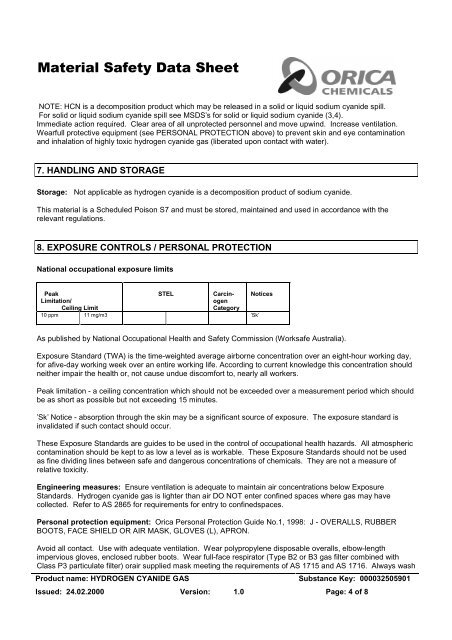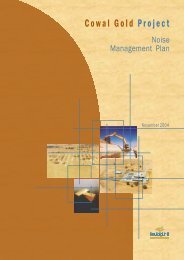January 2006 (PDF 2.9 MB) - Barrick Gold Corporation
January 2006 (PDF 2.9 MB) - Barrick Gold Corporation
January 2006 (PDF 2.9 MB) - Barrick Gold Corporation
Create successful ePaper yourself
Turn your PDF publications into a flip-book with our unique Google optimized e-Paper software.
0DWHULDO 6DIHW\ 'DWD 6KHHW<br />
NOTE: HCN is a decomposition product which may be released in a solid or liquid sodium cyanide spill.<br />
For solid or liquid sodium cyanide spill see MSDS’s for solid or liquid sodium cyanide (3,4).<br />
Immediate action required. Clear area of all unprotected personnel and move upwind. Increase ventilation.<br />
Wearfull protective equipment (see PERSONAL PROTECTION above) to prevent skin and eye contamination<br />
and inhalation of highly toxic hydrogen cyanide gas (liberated upon contact with water).<br />
7. HANDLING AND STORAGE<br />
Storage: Not applicable as hydrogen cyanide is a decomposition product of sodium cyanide.<br />
This material is a Scheduled Poison S7 and must be stored, maintained and used in accordance with the<br />
relevant regulations.<br />
8. EXPOSURE CONTROLS / PERSONAL PROTECTION<br />
National occupational exposure limits<br />
Peak<br />
Limitation/<br />
Ceiling Limit<br />
STEL Carcinogen<br />
Category<br />
10 ppm 11 mg/m3 ’Sk’<br />
Notices<br />
As published by National Occupational Health and Safety Commission (Worksafe Australia).<br />
Exposure Standard (TWA) is the time-weighted average airborne concentration over an eight-hour working day,<br />
for afive-day working week over an entire working life. According to current knowledge this concentration should<br />
neither impair the health or, not cause undue discomfort to, nearly all workers.<br />
Peak limitation - a ceiling concentration which should not be exceeded over a measurement period which should<br />
be as short as possible but not exceeding 15 minutes.<br />
’Sk’ Notice - absorption through the skin may be a significant source of exposure. The exposure standard is<br />
invalidated if such contact should occur.<br />
These Exposure Standards are guides to be used in the control of occupational health hazards. All atmospheric<br />
contamination should be kept to as low a level as is workable. These Exposure Standards should not be used<br />
as fine dividing lines between safe and dangerous concentrations of chemicals. They are not a measure of<br />
relative toxicity.<br />
Engineering measures: Ensure ventilation is adequate to maintain air concentrations below Exposure<br />
Standards. Hydrogen cyanide gas is lighter than air DO NOT enter confined spaces where gas may have<br />
collected. Refer to AS 2865 for requirements for entry to confinedspaces.<br />
Personal protection equipment: Orica Personal Protection Guide No.1, 1998: J - OVERALLS, RUBBER<br />
BOOTS, FACE SHIELD OR AIR MASK, GLOVES (L), APRON.<br />
Avoid all contact. Use with adequate ventilation. Wear polypropylene disposable overalls, elbow-length<br />
impervious gloves, enclosed rubber boots. Wear full-face respirator (Type B2 or B3 gas filter combined with<br />
Class P3 particulate filter) orair supplied mask meeting the requirements of AS 1715 and AS 1716. Always wash<br />
Product name: HYDROGEN CYANIDE GAS Substance Key: 000032505901<br />
Issued: 24.02.2000 Version: 1.0 Page: 4 of 8

















